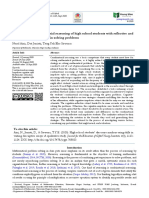Mindmap
Uploaded by
dkmmMindmap
Uploaded by
dkmm- Reason for
tooth loss
- Duration of Dental
endentulism History
- Previous
denture
experience
- Existing or
current
dentures
Profile Medial
Subjective Pteragoid
Lateral
Symmetry Pteragoid
Muscle Temporalis
Pain,
Lips
inability to Face
Masseter Sternocleidmastoid
speak/chew, Chief Social
poor Complaint Aspect
appearances,
failed Medication Temporomandibular Periodontal Pockets
Mouth Opening
Joint
prosthesis
Allergies State of Edentulism
Mucosa
Intra-Oral
Name, Age, Tongue
Teeth
Medical
Gender, Personal Arch Size/Form
History Oral Hygiene
Occupation Data
Form base for
appropriate
Extra-Oral
Recognize
treatment for
informing the
Patient Objective
Examination
Variations in patient Submandibular
Normal Physiology Posterior Auricular
Occipital
Purpose
Gather relevant Lymph Nodes
information
regarding medical Paraclinical
and psychological
factors Preauricular
Deep Cervical
Recognize normal
Obtain the status
Study Models
anatomy and Submental
of the oral cavity Recognize physiology Superficial Cervical
symptoms of - Study Morphology
- Study Occlusal Contact
Diseases
Diagnosis Interproximal
Performed before
treatment
Radiographs Periapical
Describing conditions
Computer Tomography
as positive or negative
Choice of treatment,
Informing patient
Panoramic
Main disease, causes, before restoration
Deciding nature of
disease by examination other general diseases
You might also like
- The Subtle Art of Not Giving a F*ck: A Counterintuitive Approach to Living a Good LifeFrom EverandThe Subtle Art of Not Giving a F*ck: A Counterintuitive Approach to Living a Good Life4/5 (6124)
- The Gifts of Imperfection: Let Go of Who You Think You're Supposed to Be and Embrace Who You AreFrom EverandThe Gifts of Imperfection: Let Go of Who You Think You're Supposed to Be and Embrace Who You Are4/5 (1148)
- Never Split the Difference: Negotiating As If Your Life Depended On ItFrom EverandNever Split the Difference: Negotiating As If Your Life Depended On It4.5/5 (933)
- Hidden Figures: The American Dream and the Untold Story of the Black Women Mathematicians Who Helped Win the Space RaceFrom EverandHidden Figures: The American Dream and the Untold Story of the Black Women Mathematicians Who Helped Win the Space Race4/5 (954)
- The Hard Thing About Hard Things: Building a Business When There Are No Easy AnswersFrom EverandThe Hard Thing About Hard Things: Building a Business When There Are No Easy Answers4.5/5 (361)
- The World Is Flat 3.0: A Brief History of the Twenty-first CenturyFrom EverandThe World Is Flat 3.0: A Brief History of the Twenty-first Century3.5/5 (2283)
- Devil in the Grove: Thurgood Marshall, the Groveland Boys, and the Dawn of a New AmericaFrom EverandDevil in the Grove: Thurgood Marshall, the Groveland Boys, and the Dawn of a New America4.5/5 (278)
- A Heartbreaking Work Of Staggering Genius: A Memoir Based on a True StoryFrom EverandA Heartbreaking Work Of Staggering Genius: A Memoir Based on a True Story3.5/5 (692)
- Vertical Vapor Liquid Separator Sizing: Chemical Engineering CalculationsNo ratings yetVertical Vapor Liquid Separator Sizing: Chemical Engineering Calculations8 pages
- Css Ro Details Modified Final-1310202343No ratings yetCss Ro Details Modified Final-13102023436 pages
- The Literary Translator and The Concept of FidelityNo ratings yetThe Literary Translator and The Concept of Fidelity16 pages
- Since 1989 Da Milano Is An Integral Leather Brand That Manufactures and Retails High End Leather Bags and Accessories For Both Men and Women100% (1)Since 1989 Da Milano Is An Integral Leather Brand That Manufactures and Retails High End Leather Bags and Accessories For Both Men and Women21 pages
- AWS Solutions Architect Associate Study PlanNo ratings yetAWS Solutions Architect Associate Study Plan5 pages
- [Ebooks PDF] download The Event Manager s Bible How to Plan and Deliver an Event 2nd Edition Des Conway full chapters100% (8)[Ebooks PDF] download The Event Manager s Bible How to Plan and Deliver an Event 2nd Edition Des Conway full chapters85 pages
- GR 9 Final Assessment Datesheet and SyllabusNo ratings yetGR 9 Final Assessment Datesheet and Syllabus7 pages
- Applications of Thin Airfoil Theory - Part 1No ratings yetApplications of Thin Airfoil Theory - Part 128 pages
- PR2 LAS - Quarter 1 - Week 4 - October 4 - 8 2021No ratings yetPR2 LAS - Quarter 1 - Week 4 - October 4 - 8 20214 pages
- Express Limited Warranty: FORM 6315 First EditionNo ratings yetExpress Limited Warranty: FORM 6315 First Edition2 pages
- Personal Self-Concept and Satisfaction With Life in Adolescence, Youth and AdulthoodNo ratings yetPersonal Self-Concept and Satisfaction With Life in Adolescence, Youth and Adulthood7 pages
- Cell Line Profile: ECACC Catalogue No. 84113001No ratings yetCell Line Profile: ECACC Catalogue No. 841130012 pages
- An Explicit Equation For Friction Factor in PipeNo ratings yetAn Explicit Equation For Friction Factor in Pipe2 pages
- Download Principles of Population Genetics 4th Edition Daniel L. Hartl ebook file with all chapters100% (1)Download Principles of Population Genetics 4th Edition Daniel L. Hartl ebook file with all chapters37 pages






































































